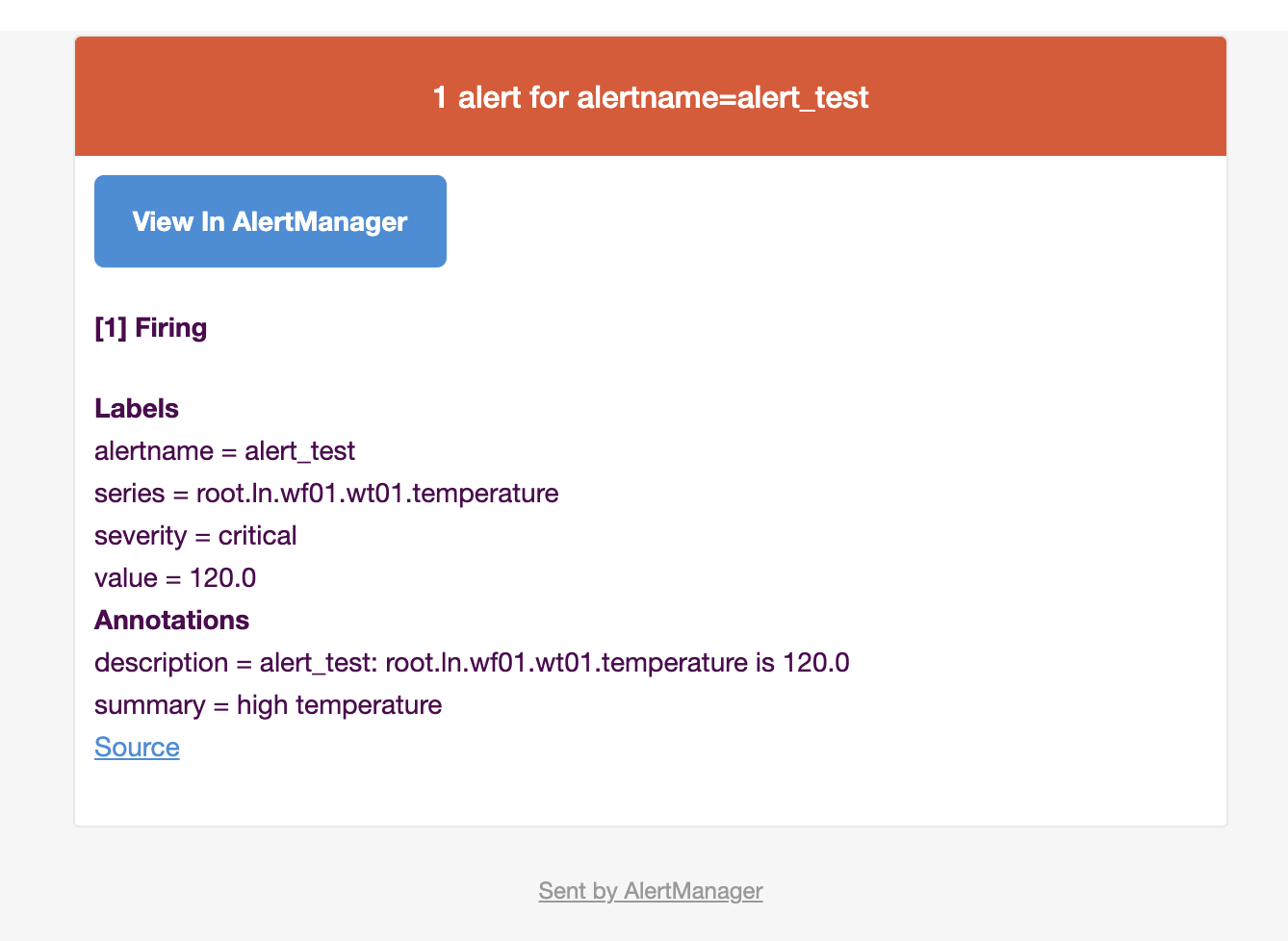告警
概览
IoTDB 告警功能预计支持两种模式:
写入触发:用户写入原始数据到原始时间序列,每插入一条数据都会触发
trigger的判断逻辑,
若满足告警要求则发送告警到下游数据接收器,
数据接收器再转发告警到外部终端。这种模式:- 适合需要即时监控每一条数据的场景。
- 由于触发器中的运算会影响数据写入性能,适合对原始数据写入性能不敏感的场景。
持续查询:用户写入原始数据到原始时间序列,
ContinousQuery定时查询原始时间序列,将查询结果写入新的时间序列,
每一次写入触发trigger的判断逻辑,
若满足告警要求则发送告警到下游数据接收器,
数据接收器再转发告警到外部终端。这种模式:- 适合需要定时查询数据在某一段时间内的情况的场景。
- 适合需要将原始数据降采样并持久化的场景。
- 由于定时查询几乎不影响原始时间序列的写入,适合对原始数据写入性能敏感的场景。
随着 trigger 模块和 sink 模块的引入,
目前用户使用这两个模块,配合 AlertManager 可以实现写入触发模式的告警。
部署 AlertManager
安装与运行
二进制文件
预编译好的二进制文件可在 这里 下载。
运行方法:
./alertmanager --config.file=<your_file>Docker 镜像
可在 Quay.io
或 Docker Hub 获得。
运行方法:
docker run --name alertmanager -d -p 127.0.0.1:9093:9093 quay.io/prometheus/alertmanager配置
如下是一个示例,可以覆盖到大部分配置规则,详细的配置规则参见
这里。
示例:
# alertmanager.yml
global:
# The smarthost and SMTP sender used for mail notifications.
smtp_smarthost: 'localhost:25'
smtp_from: 'alertmanager@example.org'
# The root route on which each incoming alert enters.
route:
# The root route must not have any matchers as it is the entry point for
# all alerts. It needs to have a receiver configured so alerts that do not
# match any of the sub-routes are sent to someone.
receiver: 'team-X-mails'
# The labels by which incoming alerts are grouped together. For example,
# multiple alerts coming in for cluster=A and alertname=LatencyHigh would
# be batched into a single group.
#
# To aggregate by all possible labels use '...' as the sole label name.
# This effectively disables aggregation entirely, passing through all
# alerts as-is. This is unlikely to be what you want, unless you have
# a very low alert volume or your upstream notification system performs
# its own grouping. Example: group_by: [...]
group_by: ['alertname', 'cluster']
# When a new group of alerts is created by an incoming alert, wait at
# least 'group_wait' to send the initial notification.
# This way ensures that you get multiple alerts for the same group that start
# firing shortly after another are batched together on the first
# notification.
group_wait: 30s
# When the first notification was sent, wait 'group_interval' to send a batch
# of new alerts that started firing for that group.
group_interval: 5m
# If an alert has successfully been sent, wait 'repeat_interval' to
# resend them.
repeat_interval: 3h
# All the above attributes are inherited by all child routes and can
# overwritten on each.
# The child route trees.
routes:
# This routes performs a regular expression match on alert labels to
# catch alerts that are related to a list of services.
- match_re:
service: ^(foo1|foo2|baz)$
receiver: team-X-mails
# The service has a sub-route for critical alerts, any alerts
# that do not match, i.e. severity != critical, fall-back to the
# parent node and are sent to 'team-X-mails'
routes:
- match:
severity: critical
receiver: team-X-pager
- match:
service: files
receiver: team-Y-mails
routes:
- match:
severity: critical
receiver: team-Y-pager
# This route handles all alerts coming from a database service. If there's
# no team to handle it, it defaults to the DB team.
- match:
service: database
receiver: team-DB-pager
# Also group alerts by affected database.
group_by: [alertname, cluster, database]
routes:
- match:
owner: team-X
receiver: team-X-pager
- match:
owner: team-Y
receiver: team-Y-pager
# Inhibition rules allow to mute a set of alerts given that another alert is
# firing.
# We use this to mute any warning-level notifications if the same alert is
# already critical.
inhibit_rules:
- source_match:
severity: 'critical'
target_match:
severity: 'warning'
# Apply inhibition if the alertname is the same.
# CAUTION:
# If all label names listed in `equal` are missing
# from both the source and target alerts,
# the inhibition rule will apply!
equal: ['alertname']
receivers:
- name: 'team-X-mails'
email_configs:
- to: 'team-X+alerts@example.org, team-Y+alerts@example.org'
- name: 'team-X-pager'
email_configs:
- to: 'team-X+alerts-critical@example.org'
pagerduty_configs:
- routing_key: <team-X-key>
- name: 'team-Y-mails'
email_configs:
- to: 'team-Y+alerts@example.org'
- name: 'team-Y-pager'
pagerduty_configs:
- routing_key: <team-Y-key>
- name: 'team-DB-pager'
pagerduty_configs:
- routing_key: <team-DB-key>在后面的示例中,我们采用的配置如下:
# alertmanager.yml
global:
smtp_smarthost: ''
smtp_from: ''
smtp_auth_username: ''
smtp_auth_password: ''
smtp_require_tls: false
route:
group_by: ['alertname']
group_wait: 1m
group_interval: 10m
repeat_interval: 10h
receiver: 'email'
receivers:
- name: 'email'
email_configs:
- to: ''
inhibit_rules:
- source_match:
severity: 'critical'
target_match:
severity: 'warning'
equal: ['alertname']API
AlertManager API 分为 v1 和 v2 两个版本,当前 AlertManager API 版本为 v2
(配置参见
api/v2/openapi.yaml)。
默认配置的前缀为 /api/v1 或 /api/v2,
发送告警的 endpoint 为 /api/v1/alerts 或 /api/v2/alerts。
如果用户指定了 --web.route-prefix,
例如 --web.route-prefix=/alertmanager/,
那么前缀将会变为 /alertmanager/api/v1 或 /alertmanager/api/v2,
发送告警的 endpoint 变为 /alertmanager/api/v1/alerts
或 /alertmanager/api/v2/alerts。
创建 trigger
编写 trigger 类
用户通过自行创建 Java 类、编写钩子中的逻辑来定义一个触发器。
具体配置流程以及 Sink 模块提供的 AlertManagerSink 相关工具类的使用方法参见 Triggers。
下面的示例创建了 org.apache.iotdb.trigger.AlertingExample 类,
其 alertManagerHandler
成员变量可发送告警至地址为 http://127.0.0.1:9093/ 的 AlertManager 实例。
当 value > 100.0 时,发送 severity 为 critical 的告警;
当 50.0 < value <= 100.0 时,发送 severity 为 warning 的告警。
package org.apache.iotdb.trigger;
/*
此处省略包的引入
*/
public class AlertingExample implements Trigger {
private final AlertManagerHandler alertManagerHandler = new AlertManagerHandler();
private final AlertManagerConfiguration alertManagerConfiguration =
new AlertManagerConfiguration("http://127.0.0.1:9093/api/v2/alerts");
private String alertname;
private final HashMap<String, String> labels = new HashMap<>();
private final HashMap<String, String> annotations = new HashMap<>();
@Override
public void onCreate(TriggerAttributes attributes) throws Exception {
alertManagerHandler.open(alertManagerConfiguration);
alertname = "alert_test";
labels.put("series", "root.ln.wf01.wt01.temperature");
labels.put("value", "");
labels.put("severity", "");
annotations.put("summary", "high temperature");
annotations.put("description", "{{.alertname}}: {{.series}} is {{.value}}");
}
@Override
public void onDrop() throws IOException {
alertManagerHandler.close();
}
@Override
public void onStart() {
alertManagerHandler.open(alertManagerConfiguration);
}
@Override
public void onStop() throws Exception {
alertManagerHandler.close();
}
@Override
public Double fire(long timestamp, Double value) throws Exception {
if (value > 100.0) {
labels.put("value", String.valueOf(value));
labels.put("severity", "critical");
AlertManagerEvent alertManagerEvent = new AlertManagerEvent(alertname, labels, annotations);
alertManagerHandler.onEvent(alertManagerEvent);
} else if (value > 50.0) {
labels.put("value", String.valueOf(value));
labels.put("severity", "warning");
AlertManagerEvent alertManagerEvent = new AlertManagerEvent(alertname, labels, annotations);
alertManagerHandler.onEvent(alertManagerEvent);
}
return value;
}
@Override
public double[] fire(long[] timestamps, double[] values) throws Exception {
for (double value : values) {
if (value > 100.0) {
labels.put("value", String.valueOf(value));
labels.put("severity", "critical");
AlertManagerEvent alertManagerEvent = new AlertManagerEvent(alertname, labels, annotations);
alertManagerHandler.onEvent(alertManagerEvent);
} else if (value > 50.0) {
labels.put("value", String.valueOf(value));
labels.put("severity", "warning");
AlertManagerEvent alertManagerEvent = new AlertManagerEvent(alertname, labels, annotations);
alertManagerHandler.onEvent(alertManagerEvent);
}
}
return values;
}
}创建 trigger
如下的 sql 语句在 root.ln.wf01.wt01.temperature
时间序列上注册了名为 root-ln-wf01-wt01-alert、
运行逻辑由 org.apache.iotdb.trigger.AlertingExample
类定义的触发器。
CREATE TRIGGER `root-ln-wf01-wt01-alert`
AFTER INSERT
ON root.ln.wf01.wt01.temperature
AS "org.apache.iotdb.trigger.AlertingExample"写入数据
当我们完成 AlertManager 的部署和启动、Trigger 的创建,
可以通过向时间序列写入数据来测试告警功能。
INSERT INTO root.ln.wf01.wt01(timestamp, temperature) VALUES (1, 0);
INSERT INTO root.ln.wf01.wt01(timestamp, temperature) VALUES (2, 30);
INSERT INTO root.ln.wf01.wt01(timestamp, temperature) VALUES (3, 60);
INSERT INTO root.ln.wf01.wt01(timestamp, temperature) VALUES (4, 90);
INSERT INTO root.ln.wf01.wt01(timestamp, temperature) VALUES (5, 120);执行完上述写入语句后,可以收到告警邮件。由于我们的 AlertManager 配置中设定 severity 为 critical 的告警
会抑制 severity 为 warning 的告警,我们收到的告警邮件中只包含写入(5, 120) 后触发的告警。

